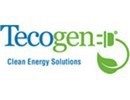With the fast growth of AI tools and technology, it was only a matter of time before it was used to optimize a building’s carbon footprint and efficiency. "For CEA facilities, this potential is unlocked through utilizing Tecogen’s hybrid chiller as the driving force for their HVAC system," says Abinand Rangesh, CEO at Tecogen. To understand how this technology works, we must first take a step back and look at where our electricity is produced. "In 2023, about 60% of the electricity generated in the US was from fossil fuels, and of the other 40%, 20% was from nuclear, and 20% was split between wind, solar, and hydro. As much as we hope that there will be more renewable energy available soon, the reality is that taking energy efficiency measures now has a much bigger impact, so choose an HVAC system that helps."
 Electricity production fuel mix of the US in 2023
Electricity production fuel mix of the US in 2023
Tecogen’s method
On the surface, only 20% of the electricity generated is from renewable energy, but that doesn’t take into account that renewable energy sources fluctuate up and down depending on how much solar or wind resources are available at that moment, Abinand explains. "Renewable energy is referred to as a base load source because we always take the maximum amount that’s produced, and then a marginal fuel source is required to fill in the change of demand throughout the day. This marginal fuel is almost always a natural gas power plant that needs to ramp up and down and causes a lot of dirty emissions. In the US, you can find real-time fuel mix in your area so it becomes possible to adapt in real time to the changes in fuel mix if you can utilize multiple fuels on site."
This is what Tecogen’s hybrid chiller and AI technology have been able to accomplish. "Like a hybrid car, Tecogen’s hybrid chiller can be powered by a natural gas engine or the grid’s electricity. If the goal is to optimize your facility for carbon savings, then the hybrid chiller may lean on the grid’s electricity during the day, while solar power is greater, and it may lean on the natural gas engine at night when the grid is dirtier. The AI software tracks and adapts to the constantly changing fuel sources, making your facility have true carbon savings."
 Tecogen’s hybrid chiller
Tecogen’s hybrid chiller
How does using natural gas equal carbon savings?
“The difference from using natural gas on-site compared to a power plant is the ability to capture the heat byproduct created during the fuel combustion. Tecogen has mastered this ability of recovering this heat and when doing this, we have twice the efficiency of a powerplant. Plus, the highest demand happens during the hottest times because that is when everyone is running their air conditioners. This is when that marginal fuel source (natural gas) is running flat out, and the grid is the dirtiest,” says Abinand.
In addition to carbon savings, Tecogen’s chillers can often find large operational cost savings when utilizing natural gas and heat recovery. "The price difference between utility-bought electricity vs. natural gas is startling, and CEA facilities can almost always turn down/off their boilers when using a Tecogen chiller. This creates an energy-efficient system that produces minimal waste, and for that reason, the US federal government has granted all Tecogen products with a 40% Investment Tax Credit. Which can be used to discount nearly the full installation of a Tecogen product by 40%," Abinand adds.
The Tecogen team will happily explain more at IndoorAgCon, booth 1506.
For more information:
Tecogen
[email protected]
www.tecogen.com
